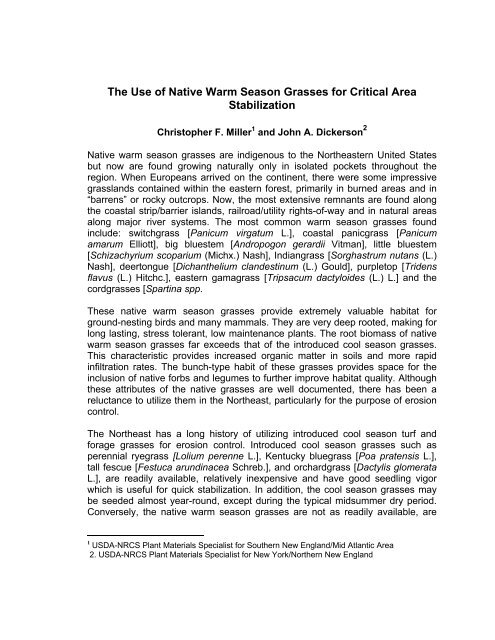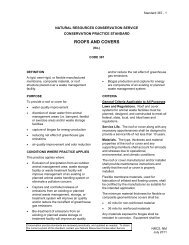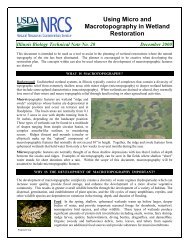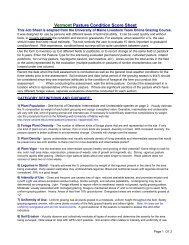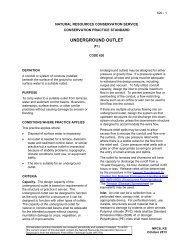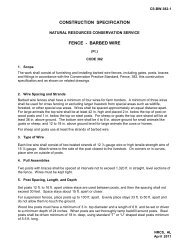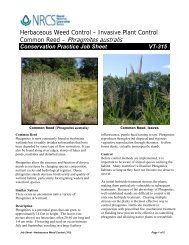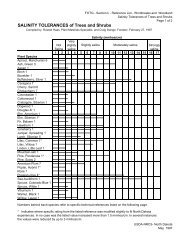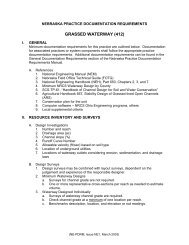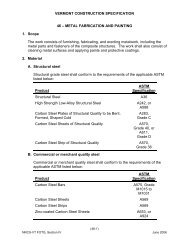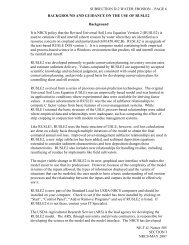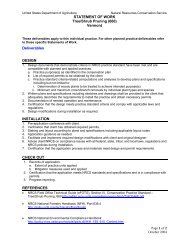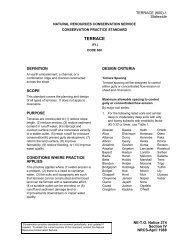The Use of Native Warm Season Grasses for Critical Area Stabilization
The Use of Native Warm Season Grasses for Critical Area Stabilization
The Use of Native Warm Season Grasses for Critical Area Stabilization
Create successful ePaper yourself
Turn your PDF publications into a flip-book with our unique Google optimized e-Paper software.
<strong>The</strong> <strong>Use</strong> <strong>of</strong> <strong>Native</strong> <strong>Warm</strong> <strong>Season</strong> <strong>Grasses</strong> <strong>for</strong> <strong>Critical</strong> <strong>Area</strong><strong>Stabilization</strong>Christopher F. Miller 1 and John A. Dickerson 2<strong>Native</strong> warm season grasses are indigenous to the Northeastern United Statesbut now are found growing naturally only in isolated pockets throughout theregion. When Europeans arrived on the continent, there were some impressivegrasslands contained within the eastern <strong>for</strong>est, primarily in burned areas and in“barrens” or rocky outcrops. Now, the most extensive remnants are found alongthe coastal strip/barrier islands, railroad/utility rights-<strong>of</strong>-way and in natural areasalong major river systems. <strong>The</strong> most common warm season grasses foundinclude: switchgrass [Panicum virgatum L.], coastal panicgrass [Panicumamarum Elliott], big bluestem [Andropogon gerardii Vitman], little bluestem[Schizachyrium scoparium (Michx.) Nash], Indiangrass [Sorghastrum nutans (L.)Nash], deertongue [Dichanthelium clandestinum (L.) Gould], purpletop [Tridensflavus (L.) Hitchc.], eastern gamagrass [Tripsacum dactyloides (L.) L.] and thecordgrasses [Spartina spp.<strong>The</strong>se native warm season grasses provide extremely valuable habitat <strong>for</strong>ground-nesting birds and many mammals. <strong>The</strong>y are very deep rooted, making <strong>for</strong>long lasting, stress tolerant, low maintenance plants. <strong>The</strong> root biomass <strong>of</strong> nativewarm season grasses far exceeds that <strong>of</strong> the introduced cool season grasses.This characteristic provides increased organic matter in soils and more rapidinfiltration rates. <strong>The</strong> bunch-type habit <strong>of</strong> these grasses provides space <strong>for</strong> theinclusion <strong>of</strong> native <strong>for</strong>bs and legumes to further improve habitat quality. Althoughthese attributes <strong>of</strong> the native grasses are well documented, there has been areluctance to utilize them in the Northeast, particularly <strong>for</strong> the purpose <strong>of</strong> erosioncontrol.<strong>The</strong> Northeast has a long history <strong>of</strong> utilizing introduced cool season turf and<strong>for</strong>age grasses <strong>for</strong> erosion control. Introduced cool season grasses such asperennial ryegrass [Lolium perenne L.], Kentucky bluegrass [Poa pratensis L.],tall fescue [Festuca arundinacea Schreb.], and orchardgrass [Dactylis glomerataL.], are readily available, relatively inexpensive and have good seedling vigorwhich is useful <strong>for</strong> quick stabilization. In addition, the cool season grasses maybe seeded almost year-round, except during the typical midsummer dry period.Conversely, the native warm season grasses are not as readily available, are1 USDA-NRCS Plant Materials Specialist <strong>for</strong> Southern New England/Mid Atlantic <strong>Area</strong>2. USDA-NRCS Plant Materials Specialist <strong>for</strong> New York/Northern New England
more expensive, and have relatively low seedling vigor compared to cool-seasongrasses, which results in a longer establishment period.<strong>The</strong>re are other reasons <strong>for</strong> reluctance to using warm season grasses. A warmseason grass seedling partitions initial energy into root development so seedlingsare vulnerable to competition and frost heave until the end <strong>of</strong> the second growingseason. <strong>The</strong> primary seeding window is limited to the early spring, but latefall/early winter seedings are a possible option on droughty soils with little weedcompetition. <strong>The</strong>re is no late summer/early fall seeding window as with coolseason grasses. Many <strong>of</strong> the warm season grasses produce chaffy seeds withlong awns, which do not efficiently flow through a conventional grass seeder. Asa result, specialized seed drills, which handle this type <strong>of</strong> seed, are needed, buthave not been commonly available in the Northeast. However, recent purchases<strong>of</strong> native grass seed drills by Soil Conservation Districts, grass-rootsenvironmental and wildlife organizations, and the U.S. Fish and Wildlife Servicehave greatly improved the availability <strong>of</strong> native grass drills in the Northeastregion.In general, warm season grasses have more exacting requirements <strong>for</strong>establishment than do cool season grasses. However, the benefits <strong>of</strong> utilizing thenative grasses far outweigh the potential difficulties encountered. This articleintends to minimize the concerns with establishing native warm season grasses<strong>for</strong> erosion control by presenting recommendations which have proven to besuccessful in the Northeast <strong>for</strong> the last eighteen years.Site SelectionSuitable planting sites <strong>for</strong> warm season grasses have the following attributes:1. Soil drainage class <strong>of</strong> moderately well drained or better, with no history<strong>of</strong> frost heave. Frost heave is less <strong>of</strong> a threat in states with longer and/or warmersummers than we have in New York, Vermont, New Hampshire, Maine,Massachusetts, and southeastern Canada. Even within the frost heave area,sandy or gravely soils rarely have this problem.2. Good control <strong>of</strong> perennial cool season grasses and <strong>for</strong>bs. Weedcompetition is typically much lower on critical area stabilization sites such asmined areas, sanitary landfill caps, and other disturbed areas due to poor soilconditions.3. At least a 100-day frost-free season, and 1600 growing degree days(corn <strong>for</strong>mula).
4. Full sun with south, west and east exposures at elevations below 2000feet in plant hardiness zone 3 or warmer. A northern exposure limits elevations tobelow 1500 ft. and to slopes <strong>of</strong> less than 20 degrees in plant hardiness zone 4 orwarmer. Add 500 feet to elevation limits <strong>for</strong> each warmer hardiness zone.5. Soil pH <strong>of</strong> 5.5 or higher with moderate or low N, P, K.Site Preparation<strong>The</strong> area to be planted should be firm and free <strong>of</strong> weeds, large rocks, stumpsand other debris over 2” in diameter.Weed competition is typically not a problem on critical area planting sites due tothe sterile, droughty soil conditions which <strong>of</strong>ten exist in disturbed areas.However, perennial cool season grasses pose the biggest threat to warm seasongrass establishment and must be addressed the year prior to planting if they arepresent. Contact herbicides such as Roundup, Poast, Fusilade, Gramoxone, 2,4-D, and Banvel combined with tillage, are effective ways to eliminate perennialweeds. All herbicides must be used according to the label requirements.Planting ProcedureSwitchgrass, coastal panicgrass, deertongue, purpletop, and eastern gamagrasscan be planted with conventional grass or grain seeding equipment because theseed will meter through the feed mechanisms. <strong>The</strong> bluestems, Indiangrass, andcordgrass have chaffy seed which requires either broadcasting or a native grassdrill with “picker wheel” feed mechanisms and hopper agitation. Easterngamagrass can be planted with a corn planter if a <strong>for</strong>age stand is desired.Drills should be set to plant 0.25 to 0.5 inch deep. Depth bands help with this,otherwise careful adjustment <strong>of</strong> the drill pressure is required. Eastern gamagrassdoes best at depths <strong>of</strong> 1 to 1.5 inches.In the Northeast, availability <strong>of</strong> native grass drills has been minimal. In addition,some sites do not lend themselves to drilling because <strong>of</strong> slope steepness orcoarse soil texture. So where the chaffy grasses are part <strong>of</strong> the seed mix,broadcasting onto a prepared seedbed is sometimes a necessity. Under theseconditions, a second pass over the site with a cultipacker (with tines raised) or abulldozer (tracking) must be used to incorporate the seed into the soil.Hydroseeding without tracking or cultipacking is unacceptable. Mixing chaffyseed with dry vermiculite or oat seed will sometimes allow <strong>for</strong> flow throughfertilizer spreaders, but this takes some experience with particular machines tomake it work.
Apply mulch if needed. Acceptable amounts <strong>of</strong> mulch (0.5-1.0 ton ac -1 ) can varybased upon the planting method to be used, but heavy mulching (2 ton ac -1 .)rates are unacceptable because this will hinder soil warming and light penetrationto the developing seedlings.Planting Dates<strong>The</strong> ideal planting dates <strong>for</strong> seeding warm season grasses range from April 15 inthe Mid-Atlantic States to May 15 in northern New England. This roughlyapproximates corn planting season. Late plantings increase the risk <strong>of</strong> frostheave on moderately well drained soils, because the seedlings will not be aslarge as they would have been with a longer growing season. Late plantings alsoincrease the risk <strong>of</strong> hitting a dry period, and further delaying germination.However, delaying planting to the end <strong>of</strong> corn planting season is justified if finalweed control is required. Where weed control has been very effective the yearprior to planting, and/or droughty soils are present, an early planting (one to threeweeks prior to corn planting) is possible.If a cover crop is needed over the winter, plant oats in late August or earlySeptember. <strong>The</strong> oats will winterkill, thus not requiring herbicide kill in the spring,unless there are other grasses or weeds germinating at that time.Seeding Rates<strong>Warm</strong> season grass seed is sold, and planted, based upon pure live seedpounds (PLS lb.). This means that the gross weight <strong>of</strong> seed is increased tocompensate <strong>for</strong> the inert material and dead seed in the given seed lot. Buyingmixtures <strong>of</strong> seed is not recommended, rather buy the seed needed and make themix just prior to planting. This allows <strong>for</strong> better quality control, and <strong>for</strong> greaterflexibility in using planting equipment. For instance, a seed like switchgrass which“flow” can be planted out <strong>of</strong> a small seed box on a conventional drill. Smooth,flowable seeds tend to settle out <strong>of</strong> a mix with the chaffy seeds as the drillbounces across the field.Typical Grass Seeding RatesCore Mix:(<strong>Use</strong> high range if broadcast or hydroseeding)Switchgrass or Coastal panicgrass; 2-5 PLS lbs ac -1Big bluestem; 3-7 PLS lbs ac -1Little bluestem; 4-6 PLS lbs ac -1Indiangrass; 3-7 PLS lbs ac -1Deertongue; 5-8 PLS lbs ac -1
Optional additions to core seed mix if quick cover is needed <strong>for</strong> erosioncontrolNurse grasses <strong>for</strong> quick cover:Oats [Avena sativa L.] – 30 lbs ac -1 orAnnual ryegrass [Lolium multiflorum Lam.] -10 lbs ac -1Plus: companion grasses <strong>for</strong> initial and short-term coverRedtop [Agrostis gigantea Roth.] -1 lbs ac -1 orCanada wildrye [Elymus canadensis L.] – 5 lbs ac -1 orFine fescue [Festuca spp.] - 15 lbs ac -1Fine fescues include: red fescue [Festuca rubra L.], hard fescue [Festucabrevipila R. Tracy ], Chewing’s fescue [Festuca rubra var. commutata Gaudin],and sheep fescue [Festuca ovina L.]Choose these companion (cool season) grasses based on availability, price andseeding objectives. Redtop is acid tolerant and will withstand short periods <strong>of</strong>drought. Persistence is much longer on wetter, poorly drained sites, howeverthese sites are poor candidates <strong>for</strong> warm season grasses. Canada wildrye hasfair drought tolerance, but good salt tolerance. <strong>The</strong> fine fescues will persist <strong>for</strong>many years under droughty, acid, and sterile soil conditions.Adding the following legumes improves soil conditioning and habitat quality:select one or two)Partridge pea [Chamaecrista fasciculata (Michx.) Greene] 4Round-headed bush clover [Lespedeza capitata Michx.] 2Wild indigo [Baptisia tinctoria (L.) R.Br.] 2Birdsfoot trefoil [Lotus corniculatus L.] 3Clover [Trifolium spp.] 2RECOMMENDED WARM SEASON GRASS CULTIVARS FOR THENORTHEASTGRASS SPECIESCULTIVAR(S)Big bluestemNiagara, Kaw[Andropogon gerardii Vitman]Coastal panicgrassAtlantic[Panicum amarum var. amarulum (Hitchc. & Chase) P.G. Palmer]DeertongueTioga[Dichanthelium clandestinum (L.) Gould]Eastern gamagrassPete[Tripsacum dactyloides (L.) L.]
IndiangrassRumsey, Osage, NE-54[Sorghastrum nutans (L.) Nash]Little bluestemAldous, Camper, Blaze[Schizachyrium scoparium (Michx.) Nash]Sand bluestemGoldstrike[Andropogon hallii Hack.]Sand lovegrass Bend, Nebraska 27[Eragrostis trichodes (Nutt.) A.W. Wood]Saltmeadow cordgrassAvalon[Spartina patens (Aiton) H.L. Muhl.]Smooth cordgrassBayshore[Spartina alterniflora Loisel.]SwitchgrassBlackwell (critical sites)[Panicum virgatum L.]Cave-in-Rock (<strong>for</strong>age-north)Carthage (<strong>for</strong>age-south)Shelter (wildlife)Managing the Establishing Stand<strong>Warm</strong> season grasses are slower to germinate than cool season grasses, <strong>of</strong>tentaking 14-21 days be<strong>for</strong>e the seedlings can be seen. To determine what iscoming up gently pass your hand just over the soil surface and “feel” theemerging leaves, then dig up some seedlings to find and identify the seed coats.Un<strong>for</strong>tunately, weeds do not have low seedling vigor. <strong>The</strong> best treatment, whenweeds begin to shade the grass seedlings, is to clip the weeds just above thegrass leaves with a sickle-bar mower. Cut <strong>of</strong>f as little grass leaf surface aspossible although a leaf tip here and there is no problem. Two to three clippingsare almost always needed during the first growing season, sometimes more. Arotary mower can be used as long as it can be elevated high enough, but it tendsto leave clippings in wads and windrows rather than thinly and evenly depositedover the field.Dry weather after the seedlings are 3-4 inches tall is not a problem and, in fact,will help the warm season grass by putting the brakes on the cool season grassseedlings that are sure to be growing along with the plants desired. <strong>The</strong>re<strong>for</strong>e,irrigation is not warranted.Fertilizer applications are recommended only if the area is essentially weed freein mid-July to early August. Apply 30-40 pounds per acre <strong>of</strong> nitrogen to give thewarm season grasses a boost, but do not apply any after August 1 in thenorthern states or August 20 in the southern part <strong>of</strong> the region.When broad-leaved weeds are a problem, Banvel and 2,4-D are the herbicides <strong>of</strong>choice. <strong>The</strong>se can be used once the planted grasses are six inches tall with atleast four leaves. All herbicides must be used following label requirements.
Second Year Management<strong>The</strong>re may be an opportunity to control cool season grasses by spot treatmentduring the spring. If sufficient growth occurs on the cool season grasses be<strong>for</strong>eany green growth appears on the warm season grasses, judicious use <strong>of</strong>Roundup is possible.Annual weeds will be crowded by the developing stand <strong>of</strong> warm season grassesand are rarely a factor in stands with good density after year one.For <strong>for</strong>age plantings, apply 60 lb. ac -1 <strong>of</strong> nitrogen after the grass has about sixinches <strong>of</strong> growth. Forage harvests, as hay or pasture, should begin as the stemsbegin to elongate (early boot stage), and end six weeks be<strong>for</strong>e expected frost.Grazing should follow an intensive rotational system. Harvest should allow atleast six inches height to remain. Consult other references <strong>for</strong> detailed harveststrategies.Case StudiesNew York/Northern New England1. Franklin Co, NY (extreme northern NY), Plant Hardiness Zone 4. Gravel pitplanting in 1975 comparing cool season and warm season grass varieties <strong>for</strong>long term droughty site persistence. Cool season grasses were ineffective <strong>for</strong>erosion control and wildlife habitat. <strong>Warm</strong> season grasses provided good coverand microsites <strong>for</strong> native woody vegetation establishment. Plantings were part <strong>of</strong>a 10-site 6-state test which was reported in the Journal <strong>of</strong> Soil and WaterConservation, Sept-Oct, 1987. <strong>The</strong>se plots served as the basis <strong>for</strong> matchingplant species selection to soils based on percent fines passing #200 mesh sieve.2. Gravel pit near Montpelier, VT, Plant Hardiness Zone 4. Planted in 1985 usingwarm-season grass mix including ‘Niagara’ big bluestem, ‘Blackwell’ switchgrass,‘Osage’ Indiangrass, and ‘Aldous’ little bluestem. This site was used as ademonstration <strong>of</strong> tracking in the seed with a bulldozer. This planting method hasbeen found repeatedly to be superior on steep slopes where the use <strong>of</strong> a seeddrill is impossible. <strong>The</strong> tracking technique following broadcasting (by hand,mechanically, or hydroseeder) results in excellent germination in the cleat tracks.<strong>The</strong> difference is typically dozens <strong>of</strong> seedlings per square foot vs. 0-2 seedlingsper square foot where only surface application is done.3. Soil bioengineering planting in November, 1988, near Gaysville, VT on asteep, dry slope. ‘Cape’ American beachgrass [Ammophila breviligulata Fernald]planted between contour lines <strong>of</strong> ‘Streamco’ purpleosier willow [Salix purpurea L.]
wattles. Cape per<strong>for</strong>med well <strong>for</strong> a few years until the willows eventuallydominated. This combination stabilized the slope by creating a favorablemicroclimate <strong>for</strong> seed recruitment from the adjacent native trees and.4. Soil bioengineering, tidal stream, Wells, ME, Plant Hardiness Zone 5.Emergency Watershed Protection planting in June 1993 following severe springflooding. Bank erosion within 8 ft from house foundations. Combination planting<strong>of</strong> ‘Streamco’ purpleosier willow, ‘Bankers’ dwarf willow [Salix cottetii Jos. Kern],and ‘Cape’ American beachgrass were planted. Cape provided initial stabilizationthen was crowded out by willows. Homeowners expectations were exceeded bythe results <strong>of</strong> the planting which were preferable to rip-rap to the top <strong>of</strong> the bank.5. <strong>Warm</strong> season grass cover <strong>for</strong> landfill reclamation at Roxbury and Williston VT,and Cortland, NY, using mixtures <strong>of</strong> ‘Shelter’ switchgrass, ‘Niagara’ big bluestem,‘Atlantic’ coastal panicgrass, ‘Bend’ sand lovegrass, and ‘Osage’ or ‘Rumsey’Indiangrass. <strong>The</strong>se sites have soils with low percent <strong>of</strong> fines, droughty capmaterials, especially in eastern NY and New England. <strong>The</strong> major obstacle tousing warm season mix was the relatively slow establishment and the resultingpossibility <strong>of</strong> erosion during the first summer. ‘Atlantic’ and ‘Bend’ provideimproved establishment during this process, then they are dominated by theother species over time. Due to winter injury, ‘Atlantic’ is only reliable <strong>for</strong> the first2 years in NY and northern New England. Other landfill sites such as Fresh Killson Staten Island and Pelham Bay in the Bronx are now using this approach toprovide long-term, low maintenance, high value wildlife cover.6. <strong>Warm</strong> season grass seeding at the East Corinth landfill in eastern Vermont.<strong>The</strong> native grass seed was tracked in with a dozer. Seeding was a success, butengineers insisted that the site had to be mowed. <strong>The</strong> cover struggled undermowing but has become well established since mowing was abandoned as amaintenance strategy.7. <strong>The</strong> Elizabeth copper mine tailings site in central Vermont. <strong>The</strong> site was bareand highly erosive <strong>for</strong> 40 years with no native plant establishment except <strong>for</strong>broadleaved cattail [Typha latifolia L.] in a wet spot. Plantings <strong>of</strong> warm seasongrass plots in 1988 demonstrated the ability <strong>of</strong> the major species to tolerate theheavy metal concentrations and low pH at the site. A light lime (1000 lbs ac -1 )and fertilizer application (40 lbs ac -1 ) was made at planting and tracked in withthe seed. No soil was applied to the site.8. A titanium and iron mine in Tahawas, NY (eastern Adirondacks) Zone 4, 1500ft elevation. <strong>Warm</strong> season grass mix, 1000 lbs. <strong>of</strong> lime and 80 lbs. <strong>of</strong> N-P-K wereapplied per acre, then tracked in with a dozer.9. Sand bluestem is not native to the Northeast. Like sand lovegrass it is veryuseful in mixes destined <strong>for</strong> use on droughty, low-fines sites. ‘Goldstrike’ sand
luestem from Nebraska is per<strong>for</strong>ming well after 10 years at the Swanton Airportin extreme northern Vermont, a few miles from Quebec Province (plant hardinesszone 3).Southern New England/Mid-Atlantic1. Watershed Protection Project in Berkshire Mountains, MA (elevation 1800’)Indiangrass, big bluestem, and little bluestem were seeded in November 1997along with cool season companion grasses, redtop and Canada wildrye. Lightmulch was applied after seeding. <strong>The</strong> project site was fertilized in the earlysummer with a liquid fertilizer. By late summer 1998, seedlings <strong>of</strong> big and littlebluestem were present on the site along with a good cover <strong>of</strong> redtop andscattered stands <strong>of</strong> Canada wildrye. After the second growing season (summer1999), seedlings <strong>of</strong> all the native grasses seeded were evident throughout theproject area with some individuals producing seedheads. Only very localized rillerosion had occurred during the native grass establishment period.2. Hart-Miller Island, MD. This is a dredge containment facility <strong>for</strong> materialdredged to keep the Baltimore Harbor shipping channel open. <strong>The</strong> containmentdike is composed <strong>of</strong> unconsolidated coarse-textured sands and gravels. <strong>The</strong>dikes have a 1:1 slope (45 degree) slope which preludes the use <strong>of</strong> any seedbedpreparation or seed drilling equipment on the slope. <strong>The</strong> grass mix composed <strong>of</strong>‘Atlantic’ coastal panicgrass, ‘Blackwell’ switchgrass, weeping lovegrass,partridge pea, and ‘Lathco’ flat pea [Lathyrus sylvestus L.] was hydroseeded ontothe slope. A chain was then dragged across the slope to improve seed to soilcontact. Also, a liquid fertilizer was added to provide some nutrients to the sterilesoil. A fully established stand was present after two growing seasons. Sevenyears after seeding the warm season grasses are persisting well.3. Hopatcong Civic Center northern New Jersey. <strong>Warm</strong> season grasses wereseeded on a barren, gravelly to cobbly outwash slope. Prior attempts to establishcool season grasses on the site were unsuccessful. <strong>The</strong> native seeds werebroadcast and tracked in with a bulldozer. A full stand <strong>of</strong> native grassesdeveloped within two growing seasons and is persisting five years after seeding.4. Coastal strip (NJ, DE, MD). ‘Atlantic’ coastal panicgrass was successfullyseeded in back dune areas between rows <strong>of</strong> beachgrass. Seeding has beendone with a simple garden seeder (Planter Jr.) set at a 1 1/2”-2” depth. Seedlingsemerging the first year generally ranged from 2”-8” in height. Within threegrowing seasons, the coastal panicgrass crowded out American beachgrass, apioneer plant, and dominated the site with the long-term cover.
Summary<strong>Warm</strong> season grasses have become an important tool <strong>for</strong> conservation plantingsin the Northeast. <strong>The</strong> benefits which these grasses bring to the planting siteinclude long life, compatibility with <strong>for</strong>bs, superior root production, soilimprovement, and wildlife habitat. Natural resource agencies should be findingways to incorporate the use <strong>of</strong> these grasses in their programs, but are cautionedto utilize effective site selection and planting procedure criteria.ReferencesDickerson, J.A., B. Wark, D. Burgdorf, R. Maher, A. Bush, W. Poole, and C.Miller. 1997. Vegetating with <strong>Native</strong> <strong>Grasses</strong> in Eastern North America. USDA-Natural Resources Conservation Service and Ducks Unlimited Canada. 63p.Gaffney, F.B. and J.A. Dickerson. 1987. Species Selection <strong>for</strong> RevegetatingSand and Gravel Mines in the Northeast. Journal <strong>of</strong> Soil and WaterConservation. 42:358-361.Vickery, P.D. and P.W. Dunwiddie. 1997. Grasslands <strong>of</strong> Northeastern NorthAmerica. Massachusetts Audubon Society, Lincoln, MA. 297p.Weaver, J.E. 1968. Prairie Plants and <strong>The</strong>ir Environment. University <strong>of</strong> NebraskaPress, Lincoln, NE. 276p.


